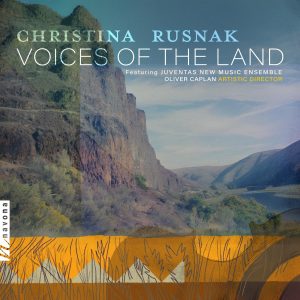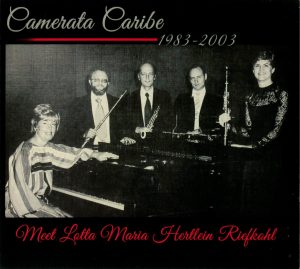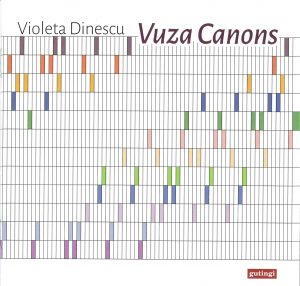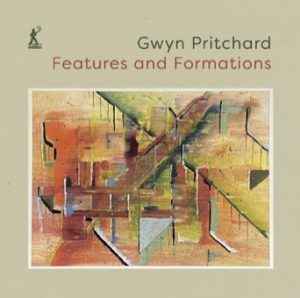
TCO Audio Reviews: May 2024
 Voices of the Land. Celine Ferro, bass clarinet; Juventas New Music Ensemble: Oliver Caplan, artistic director; Ryan Shannon, violin; Mina Lavcheva, violin; Sho Kato, flute; Thomas Barth, cello; Thomas Schmidt, marimba and percussion; Jonathan Hess, percussion; Robinson Pyle, trumpet; Brian Gardiner, percussion; Wanyue Ye, percussion. C. Rusnak: Coal Creek; Free Land; The Way Through; Canyon Voices; Oregon Trail; Pine Meadow. Navona, NV6553. Total time: 64:00.
Voices of the Land. Celine Ferro, bass clarinet; Juventas New Music Ensemble: Oliver Caplan, artistic director; Ryan Shannon, violin; Mina Lavcheva, violin; Sho Kato, flute; Thomas Barth, cello; Thomas Schmidt, marimba and percussion; Jonathan Hess, percussion; Robinson Pyle, trumpet; Brian Gardiner, percussion; Wanyue Ye, percussion. C. Rusnak: Coal Creek; Free Land; The Way Through; Canyon Voices; Oregon Trail; Pine Meadow. Navona, NV6553. Total time: 64:00.
Voices of the Land is a recent project by composer and outdoor enthusiast Christina Rusnak. Overall, it is a series of works for ensemble which creates themes based upon national parks, historical areas, and natural sites. Each piece is performed by the Juventas ensemble, an aptly named new music ensemble of young and ecologically engaged performers. The works on the album explore their natural subjects through a combination of interleaving textures, repetitive motives, and flowing melodic lines. In the words of the composer: “My assertion is that every landscape embodies multiple voices, multiple perspectives, including those of the land itself.” These works successfully demonstrate the composer’s interest in multiple perspectives, though the listener may often find a lack of direction and miss the sense of awe many experience in natural environments.
Canyon Voices, depicting Cottonwood Canyon State Park in Oregon, is the strongest selection on the album. There is a pulsing “heartbeat” throughout the seven-minute work, and Juventas’s clarinetist, Celine Ferro, is featured in a beautiful bass clarinet solo midway through the piece. Canyon Voices showcases Rusnak’s strengths as a composer including lyrical and conversational melodic lines and slowly expanding repetitive motives. As an ensemble, this piece showcases the performers careful attention to blend and collaborative playing.
At its best, Canyon Voices is a stunning testament to the beauty of both nature and music that individuals can independently express themselves, while also coming together as a holistic entity. However, Rusnak often employs similar compositional gestures and melodies, giving the works a sense of sameness and immobility. The melodies seem trapped, never fully developing into full compositional ideas. Nonetheless, Canyon Voices is an album worth listening and considering, and Juventas is an ensemble to watch in the future.
– Erin Cameron
 Camerata Caribe: Meet Lotta Maria Hertlein Riefkohl. Kathleen Jones, clarinet; Peter Kern, flute; David Bourns, oboe; Alan Brown, bassoon; Vanessa Vassallo, piano; Alberto Hernández, piano; Vanessa Vassallo, piano; Olga Merediz, vocals; Lotta Maria Hertlein Riefkohl, piano. L.M. Hertlein Riefkohl: Piano Woodwind Quintet; Jazz for oboe and piano; Homage for clarinet and piano; “At Christmas Time,” “I Have Lost my True Love.” Independent Release. Total time: 58:00.
Camerata Caribe: Meet Lotta Maria Hertlein Riefkohl. Kathleen Jones, clarinet; Peter Kern, flute; David Bourns, oboe; Alan Brown, bassoon; Vanessa Vassallo, piano; Alberto Hernández, piano; Vanessa Vassallo, piano; Olga Merediz, vocals; Lotta Maria Hertlein Riefkohl, piano. L.M. Hertlein Riefkohl: Piano Woodwind Quintet; Jazz for oboe and piano; Homage for clarinet and piano; “At Christmas Time,” “I Have Lost my True Love.” Independent Release. Total time: 58:00.
Camerata Caribe is an accomplished quintet with unique instrumentation consisting of flute, oboe, clarinet, bassoon, and piano. It was originally established in 1982 as the ensemble in residence at the Conservatory of Music of Puerto Rico. Comprised of conservatory professors, the original quintet collaborated for 20 years and initiated the composition of 66 works for their instrumentation.
At first glance, the recordings descriptive liner notes clearly illustrate the passion of the surviving members of the Camerata to preserve and share their musical legacy. The aim of this album is not only to capture live performances representing the 100+ concerts they played together as a group, but also for listeners to “meet” composer Lotta Maria Hertlein Riefkohl, as the recording is aptly subtitled. The recording contains nine tracks of Riefkohl’s music. Of which, two works feature the excellent musicianship of clarinetist Kathleen Jones: Piano Woodwind Quintet (1984), and Homage for clarinet and piano (1986).
The album’s opening quintet is composed in three movements and instantly charms the listener with this unusual blend of instruments. The musicians have an energetic rapport and soar easily around the work’s expansive melodic lines. The second movement, “Fuga,” is particularly memorable with its poignant opening line introduced by solo clarinet.
The Homage gives insight into both the composer’s imagination toward the clarinet, and Jones’s artistic skill to meet the repertoire’s demands. The first movement “Fantasia” is wonderfully rhapsodic, and the second, “Canzona,” gives the clarinet opportunity for great expression with many extended solo passages. Jones demonstrates impressive command over the quick articulation and relentless energy required in the final movement, “Tarantella.” Taken as a whole, this piece is worthy of consideration for the advanced student or young professional to explore and program as it contains a wide range of technical and lyrical challenges, as well as compelling and dynamic interplay with the pianist. Here, Jones converses seamlessly with pianist Vanessa Vassallo, both playing with a cohesivity forged by longstanding collaboration.
While there are very infrequent distortions in the audio quality due to the recording’s age, the living members of the ensemble and their talented audio engineer have indeed done a commendable job converting and improving the original cassette recordings to create this CD offering. The live recording quality does seem to capture the vibrant essence of what it must have been like to enjoy a performance from this accomplished ensemble in earlier years. Happily, though, the liner notes conclude by noting that the Camerata is still performing today and celebrated their 40th anniversary in 2023, with the addition of new conservatory professors to the roster.
– Emily Kerski
 Vuza Canons. Aurelian Octav Popa, clarinet; Carin Levine, flute; Matthias Arter, oboe; Urla Kahl, horn; Barrie Webb, trombone; Dora Entcheva, violin; Sanda Craciun Popa, viola; Katharina Deserno, cello; Mihai Ungureanu, piano; Stephan Rahn, piano with tape; Christina Ascher, alto; Markus Schäfer, tenor; Sherban Lupu, sprechstimme; Duo Conradi-Gehlen; Trio Contraste; Dauprat Horn Quartet; Concordia Wind Quintet. V. Dinescu: Round Table I, II, III, IV; Transparency I, II, III; 1989-1990; Who Called the Wolf. Gutingi. Total time: 145:17.
Vuza Canons. Aurelian Octav Popa, clarinet; Carin Levine, flute; Matthias Arter, oboe; Urla Kahl, horn; Barrie Webb, trombone; Dora Entcheva, violin; Sanda Craciun Popa, viola; Katharina Deserno, cello; Mihai Ungureanu, piano; Stephan Rahn, piano with tape; Christina Ascher, alto; Markus Schäfer, tenor; Sherban Lupu, sprechstimme; Duo Conradi-Gehlen; Trio Contraste; Dauprat Horn Quartet; Concordia Wind Quintet. V. Dinescu: Round Table I, II, III, IV; Transparency I, II, III; 1989-1990; Who Called the Wolf. Gutingi. Total time: 145:17.
Vuza Canons is a two-disc album containing nine canons by the Romanian composer Violeta Dinescu who was inspired by the work of Romanian mathematician Dan Tudor Vuza. According to the liner notes by Egbert Hiller, Vuza’s work as a mathematician involved developing a “mathematical composition process in which rhythmic patterns fill a metrical space without overlapping. The basis of each canon is an individual complex rhythm which is transferred to various fields and voices. A piece of music composed using this method consists of musical phases or moments of time units that are made up of individual notes, that are then divided up among the voices.” Although each of the canons are highly structured by the guiding mathematical principals, Dinescu uses orchestration, dynamics, tempo, and articulation to create musical interest. The result is an intriguing soundscape of musical colors that creates an effect reminiscent of pointillism.
The canons on this album are for six, twelve, and eighteen voices and Aurelian Octav Popa’s fine clarinet playing is highlighted throughout. Transparency III is a 30-minute work that contains an 18-part canon combined with sequencing for mezzo-soprano and clarinet. Although the clarinet is not featured in a way one might expect by the track title, Popa performs the extended techniques, large intervals, and the percussive interjections with ease. His brilliant, resonant tone is showcased amidst the rapidly changing musical colors.
This album is suggested for all listeners, especially those interested in an intellectual and texture-based approach to music-making. The playing is superb, and the distinctive compositions are engaging throughout. Reading the liner notes is highly recommended for those seeking insight into the unique approach and inspiration for this distinctive album.
– Kylie Stultz-Dessent
 Features and Formations. Ensemble ö!: Manfred Spitaler, clarinets; Francesc Prat, conductor; Riccarda Caflisch, flutes; David Sontòn Caflisch, violin; Sofia Suldina, violin; Maria Kropotkina, viola; Christian Hieronymi, cello; Asia Ahmetjanova, piano. G. Pritchard: Realms Apart; Calling; Calling; Features and Formations; From Time to Time; Nightfall; Res; Evolution; Tide. Métier, MEX 77109. Total time: 68:15.
Features and Formations. Ensemble ö!: Manfred Spitaler, clarinets; Francesc Prat, conductor; Riccarda Caflisch, flutes; David Sontòn Caflisch, violin; Sofia Suldina, violin; Maria Kropotkina, viola; Christian Hieronymi, cello; Asia Ahmetjanova, piano. G. Pritchard: Realms Apart; Calling; Calling; Features and Formations; From Time to Time; Nightfall; Res; Evolution; Tide. Métier, MEX 77109. Total time: 68:15.
Features and Formations is a celebration of the works and compositional techniques of British composer Gwyn Pritchard (b. 1948), and performed by Ensemble ö!, a Swiss based contemporary music ensemble. Pritchard combines planning and spontaneity quite beautifully, while often composing using an algorithmic sequence generator to lay the foundation for musical creativity and exploration.
Pritchard’s 2018 clarinet quintet Realms Apart is the first on the album, and features Manfred Spitaler, the ensemble’s clarinetist, along with principal conductor Francesc Prat. Unlike most clarinet quintets, this work is performed with the clarinet and the string quartet facing each other with over six feet between them. The work begins with a cluster of low string chords followed by intense, speedy altissimo by Spitaler. This conversation continues throughout the piece, with Spitaler using the entire range of the clarinet while the strings explore the vast possibilities of technical and timbral techniques available to them. Calling, written for pianist Asia Ahmetjanova, similarly showcases animated spurts of energy eventually giving way to a luscious, soft landscape. These two characters come and go throughout, “calling” each other, and taking the listener on a dense journey ending on just one, quick, note. Features and Formations composed for solo violin, flute, and clarinet, with cello accompaniment was inspired by Contours, an earlier work of Pritchard. Contours explored his fascination of maps and musical landscapes, taking the listener on a journey through auditory mountains, valleys, cliffs, and more. Features and Formations continues this same journey and advances each of these geographical musical ideas.
Pianist Asia Ahmetjanova returns to perform From Time to Time, the first piece to use the algorithmic sequence generator. Two main characters emerge, one of fast, thick, chunked runs and the other of soft, resonant highs and lows. The remaining tracks on the album come full circle—combining different groupings of instruments together that form this fantastic ensemble, showcasing the technical and lyrical extremes that these instruments are capable of.
– Lara Mitofsky-Neuss
Comments are closed.